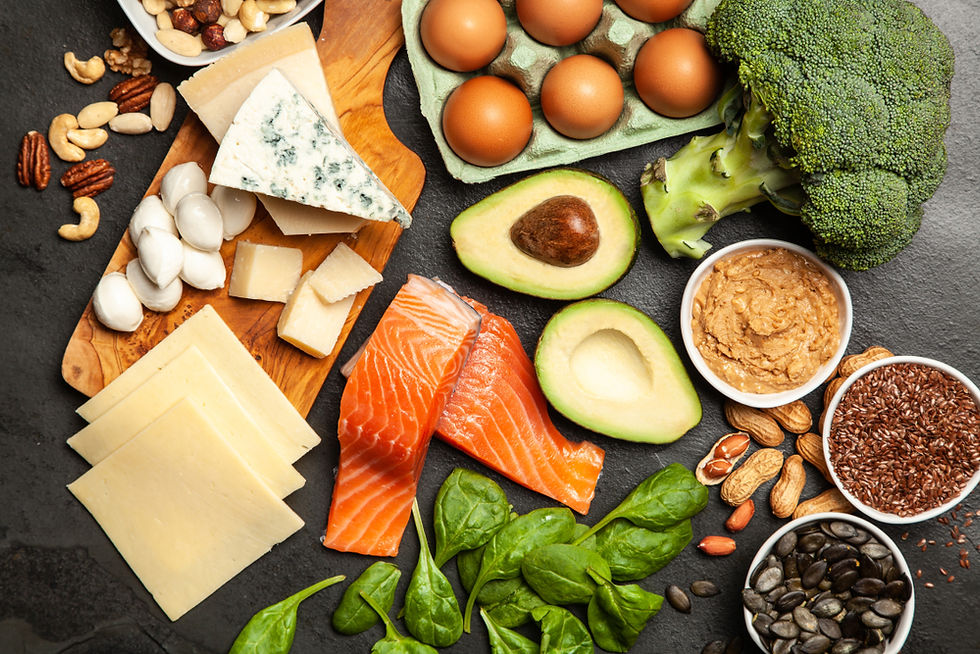HOW TO EAT 100 GRAMS OF PROTEIN A DAY: TOP MEAL STRATEGIES
- Sara Sutherland

- Jul 22
- 3 min read

Reaching your protein intake goals can be a simple and enjoyable process with the right approach. Whether you aim to build muscle, lose weight, or maintain overall health, consuming 100 grams of protein daily is achievable with careful meal planning. Here are some top strategies to help you meet your protein needs effectively.
Why Protein is Important
Protein plays a crucial role in various aspects of health and fitness:
Muscle Gain: Protein is essential for muscle repair and growth. When you engage in strength training or other forms of exercise that challenge your muscles, small tears occur in the muscle fibers. Consuming adequate protein helps repair these tears, leading to increased muscle mass and strength over time.
Weight Loss: Protein can aid in weight loss by promoting satiety, which helps control appetite and reduce overall calorie intake. Additionally, the body uses more energy to digest protein compared to fats or carbohydrates, which can boost your metabolism and aid in weight loss efforts.
Aging: As we age, maintaining muscle mass and strength becomes increasingly important for overall health and mobility. Protein helps prevent age-related muscle loss or sarcopenia and supports bone health. Adequate protein intake can enhance recovery from illness or injury and improve overall quality of life in older adults.
Start with a Protein-Packed Breakfast
Breakfast is an ideal opportunity to kickstart your protein intake. Consider incorporating options like Greek yogurt, which contains around 10 grams of protein per serving, or eggs, offering about 6 grams of protein per egg. Another excellent choice is a protein smoothie made with protein powder, milk, and fruits, easily providing 20-30 grams of protein. Adding a tablespoon of chia seeds or nut butter can further boost the protein content.
Make Lunch Protein-Centric
For lunch, focus on meals that are rich in protein to keep your energy levels up throughout the day. Grilled chicken breast, tuna salad, or a chickpea and quinoa bowl are great choices. A typical serving of chicken breast can offer about 25 grams of protein, while a cup of cooked quinoa adds 8 grams, and half a cup of chickpeas provides 7 grams. Pair these with a variety of vegetables to create a balanced and nutritious meal.
Snack Smart with Protein
Snacks are another excellent way to increase your daily protein intake. Consider options like a handful of almonds, which contain 6 grams of protein per ounce, or a protein bar, which can offer anywhere from 10 to 20 grams of protein. Other high-protein snacks include cottage cheese, jerky, or hummus with veggies. Greek yogurt and string cheese are also convenient and protein-rich options.
Protein-Rich Dinners
For dinner, aim for a protein-rich main course such as fish, lean beef, or tofu. A serving of salmon or lean beef can provide around 22-25 grams of protein, while tofu offers about 10 grams per half-cup serving. Complement these proteins with a side of lentils or beans, which add another 8-9 grams of protein per half-cup. Incorporating a variety of protein sources can make your meals more interesting and nutritionally diverse.
Other Strategies
Consider Protein Supplements
If you find it challenging to meet your protein goals through food alone, protein supplements can be a practical addition to your diet. Whey protein, casein protein, and plant-based protein powders are all excellent options. A single scoop of protein powder typically provides around 20-25 grams of protein. It can be easily mixed with water, milk, or added to smoothies. This can be particularly useful post-workout or as a quick protein boost throughout the day.
Balance and Variety are Key
While focusing on protein, it's essential to maintain a balanced diet. Include a variety of protein sources to ensure you're getting all the essential amino acids your body needs. Additionally, pair your protein intake with adequate carbohydrates and fats for overall health and energy. Whole grains, fruits, vegetables, nuts, and seeds are crucial to a well-rounded diet.
Planning and Preparation
Effective meal planning and preparation ensure you meet your protein goals. Preparing meals and snacks in advance can help you avoid the temptation of less nutritious options and ensure you always have high-protein foods on hand. Batch cooking, portioning out meals, and having ready-to-eat protein snacks can simplify your daily routine and support your dietary goals.
By integrating these strategies into your daily routine, consuming 100 grams of protein a day can become an effortless part of your lifestyle. Embrace the variety of protein-rich foods available, and enjoy the benefits of a well-balanced and nutritious diet.









Comments